Using Wind Speed and Direction to Predict MLB Scoring
The weather matters in daily fantasy baseball, and one of the most important factors is the wind. The wind can wreak havoc on a game more so than in perhaps any other sport. One of the ways you can tell that wind speed matters is when the Chicago Cubs are playing at home and there are fierce winds at Wrigley Field. In many instances, the Vegas total for that game will move as much as an entire run. Even more often, Vegas won’t even accept bets on the over/under if winds are gusting in Chicago.
Wrigley is an old ballpark that’s constructed such that gusts of wind can enter the stadium with ease and completely change the direction and speed of a batted ball. Not all ballparks are constructed in the same manner, with some blocking wind almost completely and others not at all.
Before we can break down individual stadiums, though, we need to know if/how wind direction and speed affects batted balls in general. How much does the speed matter relative to the direction, for example? Is wind that’s blowing in a lot worse than wind blowing out to centerfield? How much better is a 15mph wind over a 5mph for hitters?
Wind Speed and Direction
To help answer some of these questions, I used Baseball Reference’s Play Index to examine every game since 2000. I sorted overall runs per game and home runs per game into 12 separate categories based on wind speed and direction.
Wind Blowing Out
First, let’s take a look at how scoring and dingers are affected when the wind is blowing out toward either left field, centerfield, or right field. I used a heatmap to help visualize the difference, with red cells being the most productive situations.
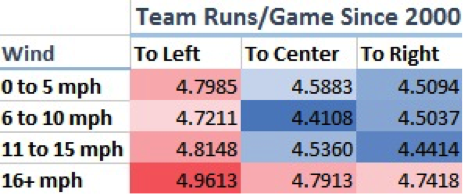
I initially assumed that wind blowing out toward center would be the most beneficial situation for hitters, but it isn’t. The four highest-scoring scenarios are all when the wind is blowing out to left field. That’s pretty incredible; games with winds in the 0-5 mph range blowing out to left have led to greater offensive production than even those with 16+ mph winds blowing out to center or right field. Nuts.
Before dissecting this data more, let’s take a look at home runs.
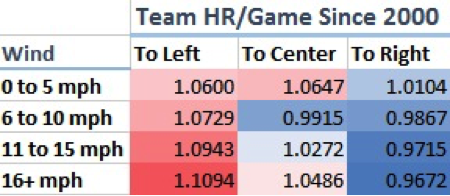
Same thing; batters are more likely to hit home runs when the wind is blowing out to left field than when it’s gusting toward center or right. In terms of home runs, anything blowing toward right field is especially bad, and it surprisingly gets worse as wind speeds increase.
So what’s going on here? I imagine this has to do with most batters being right-handed. Righties typically pull the ball to left field, so it makes sense that they’d be aided most by winds blowing out to left. That matches the data, with runs and home runs generally increasing as winds get stronger in that direction.
It could also make sense, then, that there have been fewer home runs with stronger winds to right. Those winds would likely end up forcing a ball hit to left field to move toward centerfield—a deeper part of the ballpark. Right-handed hitters who pull the ball often are thus hindered by strong winds to right, at least in terms of going deep.
What’s so shocking, though, is how much the direction matters. Even a slight breeze to left is superior to gusting winds to center, which is weird.
Analyzing things solely by wind direction, teams have produced 5.8 percent more runs and 7.6 percent more home runs when the wind is blowing out toward left field over center and right combined. The home runs peak at 10.7 percent more frequent if we analyze solely 16+ mph gusts.
No matter how you slice it, wind direction seems to matter a whole lot in baseball.
Wind Blowing In
If winds blowing out toward the pitcher are a positive for batters, you’d expect winds blowing in to be a really big negative, but that’s not at all the case.
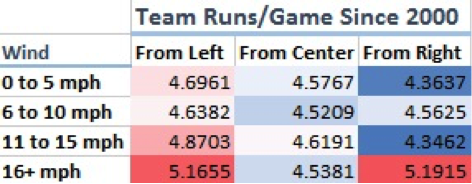
In terms of runs per game, teams have scored the most when there are 16+ mph winds blowing in from either left or right field—even more runs than when the same speed winds are blowing out.
Meanwhile, the worst situation for hitters is when the wind is directly at a pitcher’s back, blowing in from center. That likely adds velocity to pitches and also doesn’t significantly affect a pitcher’s ability to throw strikes (which could happen with winds that are blowing in from left or right field, which would likely alter a pitcher’s trajectory more than winds blowing straight in).
Note, however, that winds blowing in from right field have historically been beneficial only when they’re quite strong; slow and moderate winds haven’t produced the same boost in runs per game when blowing in from right. Meanwhile, all winds blowing in from left have been a positive for hitters.
There’s a lot to dissect here, but let’s first examine home runs per game.
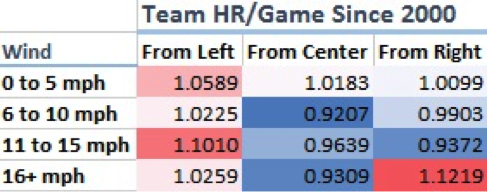
A few minor differences, but basically the same concept; winds blowing in from left are good, while most winds blowing in from center or right are bad (for hitters). The only time strong winds coming in from right field are a positive for batters is when they’re strong (16+ mph).
Okay, so now is supposed to be the part of this lesson when I tell you exactly what’s going on. The truth is I don’t really know. It makes sense that strong winds blowing out to left field would help batters, most of whom are right-handed, but what in the hell is the deal with winds blowing in?
There are so many variables at play here that it’s really difficult to determine. We might expect a pitcher’s ability to throw strikes, a batter’s ability to make solid contact, and a defender’s ability to either catch a fly ball or make an accurate throw on a ground ball to all be affected by wind speed. It’s challenging to understand how all of those variables interact based on wind speed and direction.
I think there’s still plenty of actionable information here—namely that winds blowing in from OR out to left field are a great thing for batters—but I want to examine this a bit more.
Winds Blowing Across the Field
In addition to wind blowing straight out or straight in, there are also games that have been categorized as having left-to-right or right-to-left winds. Let’s take a look at those.
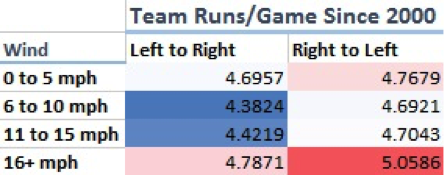
In terms of team runs, winds blowing from right to left have historically produced significantly more scoring than left-to-right winds. This fits with the data suggesting that wind blowing out to left field is better than wind blowing out to right field; a right to left wind would pull balls hit to left toward the line, which is generally a good thing (away from the leftfielder and to the shortest part of the park needed for a home run, which is usually directly down the line).

We see the same thing with home runs, which lends credibility to this idea.
Of course, all of this is likely the result of most batters being right-handed and getting aided by winds out to left field. I have more digging to do, but we should probably expect winds blowing toward right field to favor offenses with a lot of lefty bats.
Conclusions
A lot of this data makes a ton of sense, but some of it—specifically the numbers on wind blowing in from left and right field—is strange. It could be the case that winds of any type make hits more likely to fall, but the increased home run rate when the wind is blowing in (except from centerfield) is bizarre. This probably isn’t noise, either, considering I analyzed every single game played since 2000.
In the end, every stadium is different and there are all kinds of variables to consider when it comes to understanding how the wind affects the path of a batted baseball. Nonetheless, there’s certainly some actionable data here that can and should affect how you approach daily fantasy baseball, particularly when it comes to selecting pitchers and stacking offenses.
Here are a few general heuristics to help you along the way.
- 1. Wind speed matters less than wind direction when it’s blowing out; for batters, the best possible scenario is wind blowing toward left field. A weak wind to left field beats a strong wind to right.
- 2. The greatest frequency of home runs have been hit when wind is blowing in. This is pretty shocking, but wind direction in terms of if it’s blowing to the left or right matters way more than if it’s blowing in or out.
- 3. The worst wind for a batter is a strong wind blowing straight in from center. This likely adds velocity to pitches, making them more challenging to hit.
- 4. A right-to-left wind beats the opposite. Like the other data, this is probably due to the abundance of right-handed bats in baseball.